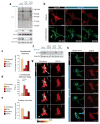Regulation of endogenous transmembrane receptors through optogenetic Cry2 clustering
- PMID: 25902152
- PMCID: PMC4408875
- DOI: 10.1038/ncomms7898
Regulation of endogenous transmembrane receptors through optogenetic Cry2 clustering
Abstract
Transmembrane receptors are the predominant conduit through which cells sense and transduce extracellular information into intracellular biochemical signals. Current methods to control and study receptor function, however, suffer from poor resolution in space and time and often employ receptor overexpression, which can introduce experimental artefacts. We report a genetically encoded approach, termed Clustering Indirectly using Cryptochrome 2 (CLICR), for spatiotemporal control over endogenous transmembrane receptor activation, enabled through the optical regulation of target receptor clustering and downstream signalling using noncovalent interactions with engineered Arabidopsis Cryptochrome 2 (Cry2). CLICR offers a modular platform to enable photocontrol of the clustering of diverse transmembrane receptors including fibroblast growth factor receptor (FGFR), platelet-derived growth factor receptor (PDGFR) and integrins in multiple cell types including neural stem cells. Furthermore, light-inducible manipulation of endogenous receptor tyrosine kinase (RTK) activity can modulate cell polarity and establish phototaxis in fibroblasts. The resulting spatiotemporal control over cellular signalling represents a powerful new optogenetic framework for investigating and controlling cell function and fate.
Conflict of interest statement
Figures




Similar articles
-
Optogenetic protein clustering through fluorescent protein tagging and extension of CRY2.Nat Commun. 2017 Jun 23;8(1):30. doi: 10.1038/s41467-017-00060-2. Nat Commun. 2017. PMID: 28646204 Free PMC article.
-
Light-Regulated Protein Kinases Based on the CRY2-CIB1 System.Methods Mol Biol. 2017;1596:257-270. doi: 10.1007/978-1-4939-6940-1_16. Methods Mol Biol. 2017. PMID: 28293892
-
Optogenetic Control of Fibroblast Growth Factor Receptor Signaling.Methods Mol Biol. 2016;1408:345-62. doi: 10.1007/978-1-4939-3512-3_24. Methods Mol Biol. 2016. PMID: 26965135
-
Optogenetic Approaches for the Spatiotemporal Control of Signal Transduction Pathways.Int J Mol Sci. 2021 May 18;22(10):5300. doi: 10.3390/ijms22105300. Int J Mol Sci. 2021. PMID: 34069904 Free PMC article. Review.
-
Optogenetic control of intracellular signaling pathways.Trends Biotechnol. 2015 Feb;33(2):92-100. doi: 10.1016/j.tibtech.2014.11.007. Epub 2014 Dec 17. Trends Biotechnol. 2015. PMID: 25529484 Free PMC article. Review.
Cited by
-
Engineered Illumination Devices for Optogenetic Control of Cellular Signaling Dynamics.Cell Rep. 2020 Jun 9;31(10):107737. doi: 10.1016/j.celrep.2020.107737. Cell Rep. 2020. PMID: 32521262 Free PMC article.
-
Near-Infrared Light-Activated DNA-Agonist Nanodevice for Nongenetically and Remotely Controlled Cellular Signaling and Behaviors in Live Animals.Nano Lett. 2019 Apr 10;19(4):2603-2613. doi: 10.1021/acs.nanolett.9b00421. Epub 2019 Mar 28. Nano Lett. 2019. PMID: 30907088 Free PMC article.
-
Layilin augments integrin activation to promote antitumor immunity.J Exp Med. 2020 Sep 7;217(9):e20192080. doi: 10.1084/jem.20192080. J Exp Med. 2020. PMID: 32539073 Free PMC article.
-
Membrane-associated periodic skeleton is a signaling platform for RTK transactivation in neurons.Science. 2019 Aug 30;365(6456):929-934. doi: 10.1126/science.aaw5937. Science. 2019. PMID: 31467223 Free PMC article.
-
An open-hardware platform for optogenetics and photobiology.Sci Rep. 2016 Nov 2;6:35363. doi: 10.1038/srep35363. Sci Rep. 2016. PMID: 27805047 Free PMC article.
References
-
- Spencer D, Wandless T, Schreiber S, Crabtree G. Controlling signal transduction with synthetic ligands. Science. 1993;262:1019–1024. - PubMed
-
- Dikic I, Schlessinger J, Lax I. PC12 cells overexpressing the insulin receptor undergo insulin-dependent neuronal differentiation. Current Biology. 1994;4:702–708. - PubMed
-
- Jiang Y, Woronicz JD, Liu W, Goeddel DV. Prevention of Constitutive TNF Receptor 1 Signaling by Silencer of Death Domains. Science. 1999;283:543–546. - PubMed
-
- Traverse S, et al. EGF triggers neuronal differentiation of PC12 cells that overexpress the EGF receptor. Current Biology. 1994;4:694–701. - PubMed
Publication types
MeSH terms
Substances
Grants and funding
LinkOut - more resources
Full Text Sources
Other Literature Sources
Molecular Biology Databases
Research Materials
Miscellaneous

